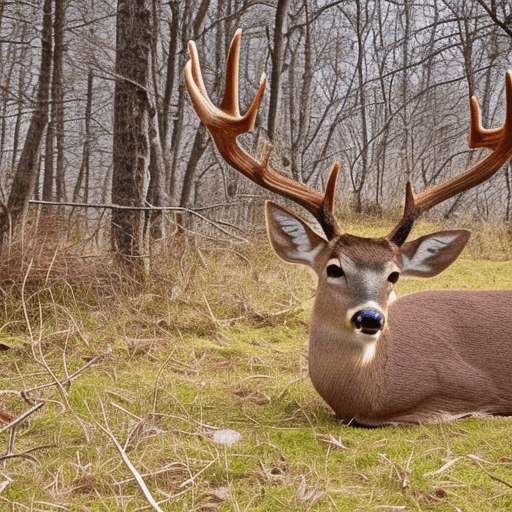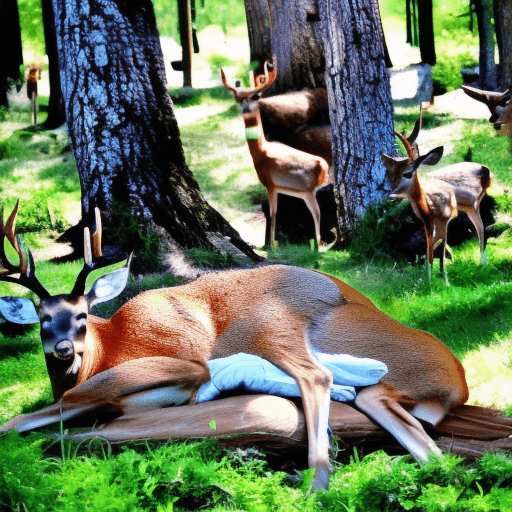Do you know where deer sleep?
Believe it or not, they sleep in a variety of different places.
In this blog post, we will explore the different places where deer like to catch some Zs.
We will also take a look at some of the benefits of sleeping in different locations.
So, where do deer sleep? Keep reading to find out!

Deer sleep where they feel safe and sheltered from the elements.
This can be in a forest, in a meadow, or even in people’s backyards.
Deer will often find a spot under a tree or shrub to bed down for the night.
Deer do not sleep soundly as humans do but rather take short naps throughout the day and night.
Where do deer sleep
Deer are mostly nocturnal animals, meaning they tend to sleep during the day and be more active at night.
However, deer will also occasionally take a nap during the day if they feel safe and undisturbed.
When it comes to finding a place to sleep, deer are not picky.
They will bed down in open fields, dense forests, or even people’s yards.
As long as there is a good supply of food and water nearby, deer will happily make themselves at home.
During the winter months, deer often spend most of their time sleeping to conserve energy.
Deer can enter a state of partial hibernation, known as torpor, to survive cold weather conditions.
Where do deer sleep during winter?
As the weather gets colder, deer begin to prepare for winter.

One of the most important things they do is to find a safe place to sleep.
Deer usually prefer to bed down in an area that offers some protection from the wind and snow.
They may choose to sleep in a wooded area, under a hedge, or even in a snowbank.
Deer will often dig out a small hollow in the snow to create a more sheltered spot.
Once they have found a suitable location, deer will usually stay there for several days at a time.
However, they will occasionally move to a new spot if the weather changes or they become disturbed.
By spending the winter in a warm, safe place, deer can weather the cold season and emerge healthy and strong in the spring.
Where do deer sleep during summer?

In summer, when food is plentiful, deer tend to sleep in open areas such as meadows or fields.
This provides them with a good view of their surroundings and makes it easier for them to escape from predators.
Interestingly, deer don’t fall asleep like other animals.
Instead, they enter a state of “light sleep” where they can still be conscious of their surroundings.
This allows them to immediately spring into action if necessary.
So the next time you’re out for a walk in the woods, keep your eyes peeled for signs of deer activity.
You might just catch a glimpse of one taking a summer nap.
What are some of the benefits of sleeping in different locations?
Deer are creatures of habit, and they typically sleep in the same place day after day.
However, there are some benefits to sleeping in different locations.
For one, it helps to camouflage the deer from predators.
If a deer is always in the same spot, it becomes easier for predators to find it.
Additionally, sleeping in different locations helps the deer to stay cool in summer and warm in winter.
By moving around, the deer can take advantage of changes in temperature and shelter that can help to regulate its body temperature.
Finally, sleeping in different locations helps the deer to stay healthy by avoiding parasites and diseases that might build up in one area.
By constantly moving, the deer reduces its exposure to potential hazards.
So while deer may be creatures of habit, there are some advantages to changing up their sleeping spots from time to time.
How do deer sleep

Deer do not have a defined sleep pattern and can sleep standing up or lying down.
Usually, deer will lie down to sleep when they feel safe and secure.
When they are nervous or afraid, they will usually stand up.
Deer usually spend about eight hours a day sleeping, but this can vary depending on the season and how much food is available.
In the winter, when food is scarce, deer may only sleep for a few hours at a time.
During the summer, when food is plentiful, they may sleep for up to 12 hours a day.
While deer do not have a defined sleep pattern, they tend to be most active at dawn and dusk.
What are some of the different places where deer sleep
Deer are creatures of habit and will often return to the same spots to sleep night after night.
Some of the places where deer have been known to bed down include thickets, wood edges, beneath fallen logs, and hollowed-out trees.
In addition, deer will also use man-made structures such as porches, decks, and sheds as a refuge from the cold.
During the day, deer will doze in these sheltered spots, rising only to feed or drink.
At night, they will curl up in a tight ball to stay warm, with their head resting on their haunches.
As a result, if you find a spot where deer have been sleeping, you’ll likely find them there again.
Why do deer sleep in different places?
Deer are unlikely to stay in the same place for long periods, as their survival depends on their ability to move quickly and quietly through their habitat.
One reason that deer sleep in different places is to avoid becoming easy prey for predators.
If a deer sleeps in the same spot every night, predators will quickly learn its patterns and be able to track it down.
Additionally, deer need to graze on a variety of plants to obtain all the nutrients they require.
By sleeping in different places, they can access a greater variety of food sources.
Finally, deer also use their sleeping habits as a way to regulate their body temperature.
In warm weather, they will seek out shady spots to rest, while in cold weather they will bed down in areas that are protected from the wind.
Usually, several deer will bed down together near for added safety and warmth.
Article Sources
Jacks of Science sources the most authoritative, trustworthy, and highly recognized institutions for our article research. Learn more about our Editorial Teams process and diligence in verifying the accuracy of every article we publish.
